



Table of Contents
- ESIC Meaning
- Eligibility for ESIC Registration
- Documents Needed for ESIC
- Online Registration ESIC
- Post-ESIC Registration Obligations
- ESIC Coverage Criteria for Various Entities
- ESIC Benefits
- Get ESI card or Pehchan Card
- Features of ESIC Card
- Login to ESIC mEUD
- Lodge a Grievance on ESIC Portal
- Check Grievance Status on ESIC
- IP number in ESIC
- ESIC IP Number Digits
- Delayed Payment of Contribution Consequences
- Contact ESIC
- Conclusion
- Faq's
ESIC Meaning
The Employees' State Insurance Corporation (ESIC) oversees the implementation of the Employees' State Insurance (ESI) scheme, a crucial initiative by the Ministry of Labour and Employment in India. The primary objective of this scheme is to ensure the comprehensive health and well-being of employees by providing them with a unique health card known as the ESI card. This card serves as a valuable resource for beneficiaries, offering access to various healthcare facilities and services in times of medical emergencies.
Enrollment in the ESI scheme is mandatory for organizations or establishments with a workforce exceeding 10 employees. This regulatory requirement is designed to extend the benefits of the scheme to a broad spectrum of workers across diverse industries. Under the ESI Act of 1948, the Employees' State Insurance Corporation operates as an autonomous body, functioning within the framework set by the Indian government.
The ESI card, issued to eligible beneficiaries, acts as a gateway to a range of medical provisions, including hospitalization, outpatient treatment, maternity benefits, and more. Through a network of ESI dispensaries, hospitals, and clinics, employees covered by the scheme gain access to quality healthcare services, promoting both preventive and curative healthcare.
The administration of the ESI scheme involves the strategic management of funds collected through contributions from both employers and employees. These funds are utilized to sustain and enhance the healthcare infrastructure, ensuring that beneficiaries receive timely and effective medical care.
The Employees' State Insurance Corporation plays a pivotal role in safeguarding the health and welfare of the workforce, contributing to the overall socio-economic development of the country by fostering a healthy and productive working population. Through the ESI scheme, the government aims to create a supportive environment for employees, alleviating the financial burden associated with healthcare expenses and promoting a robust and resilient workforce.
Eligibility for ESIC Registration
Eligibility for ESIC registration extends to any non-seasonal factory or establishment with a workforce exceeding 10 employees, and in certain states, the threshold is set at 20 employees. Importantly, these employees should have a maximum basic wages or salary of Rs. 21,000 per month (or Rs. 25,000 per month for individuals with disabilities). The obligation for mandatory registration with the Employees' State Insurance Corporation (ESIC) arises, and employers must complete this process within 15 days from the date of applicability.
The ESIC scheme operates with a dual contribution structure involving both employers and employees. Employers are required to contribute an amount equivalent to 3.25% of the total monthly wage payable to each employee covered under the scheme. Conversely, employees are mandated to contribute 0.75% of their monthly wage every month throughout the year. It's worth noting that employees with a daily wage below Rs. 176 are exempted from contributing their share under this scheme.
This comprehensive social security initiative aims to create a robust safety net for the covered workforce, ensuring access to essential healthcare services and financial support during medical contingencies. By enforcing contributions from both employers and employees, the ESIC scheme fosters a shared responsibility for the well-being of the workforce.
The registration process is a critical step for employers, as compliance with the ESIC regulations not only fulfills legal obligations but also ensures that employees can avail themselves of the numerous benefits provided under the scheme. These benefits encompass medical care, maternity benefits, sickness benefits, and more, contributing to the overall welfare of the workforce.
Documents Needed for ESIC
To initiate registration under the Employees' State Insurance (ESI) scheme, a set of vital documents is necessary to ensure compliance with the stipulated regulations. These documents serve as essential proofs of eligibility and help streamline the registration process:
Registration Certificate under the Factories Act or Establishment and Shops Act
- Evidence of the establishment's legal registration, whether under the Factories Act or Establishment and Shops Act.
Registration Certificate for Companies and Partnership Deeds for Firms
- For companies, submission of the Registration Certificate and, for firms, the partnership deeds are required to establish the legal structure.
Proof of Establishment's Address
- Documentation validating the physical location of the establishment.
Memorandum of Association and Articles of Association for Companies
- Applicable for companies, these documents outline the company's structure, objectives, and operational guidelines.
Comprehensive List of Employees with Compensation Particulars
- Detailed information about all employees, including their compensation details, to determine eligibility under the ESI scheme.
Canceled Cheque of the Company's Bank Account
- A canceled cheque from the company's bank account to facilitate seamless financial transactions.
Roster of Shareholders
- For companies, a roster detailing the shareholders involved in the establishment.
Business's PAN Card
- Submission of the Permanent Account Number (PAN) card for the business entity.
Attendance Roster for All Employees
- A record of attendance for all employees, helping to ascertain the workforce and their respective contributions.
Ensuring the meticulous compilation and submission of these documents is crucial for a smooth and successful registration process under the ESIC scheme. This comprehensive approach helps guarantee adherence to regulatory requirements and facilitates the seamless integration of establishments into the social security framework provided by the ESI scheme.
Online Registration ESIC
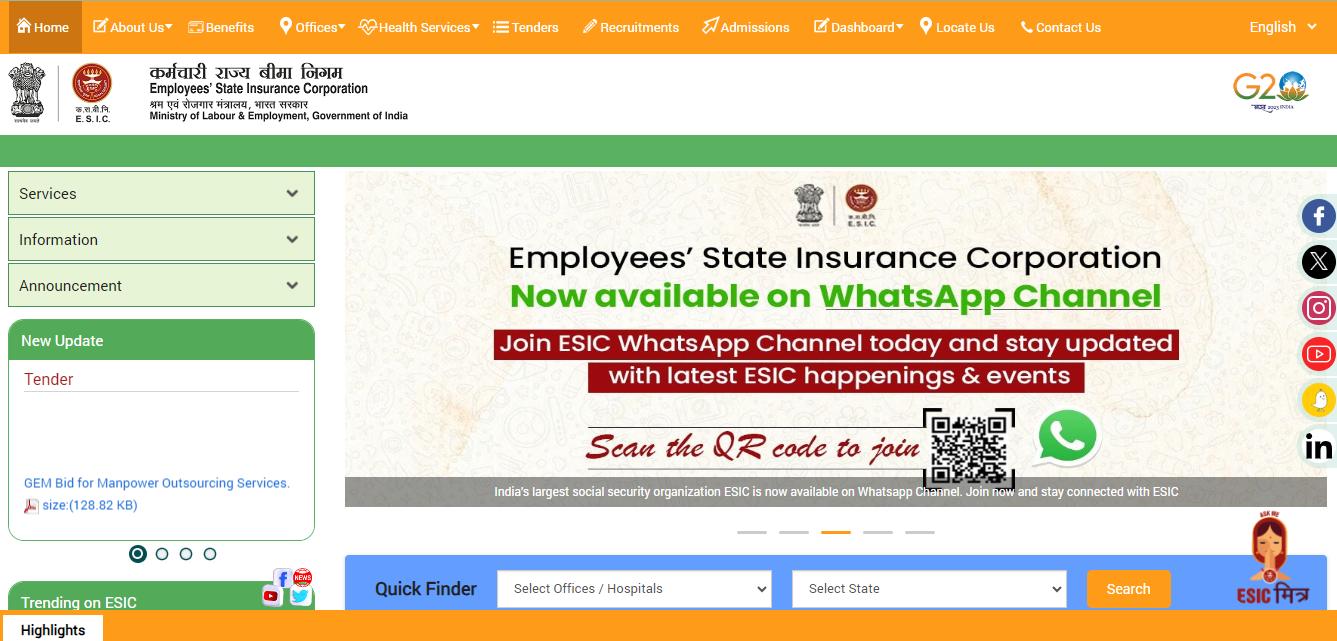
Step 1: Registering on the ESIC Portal
To initiate the registration process on the ESIC portal, an employer is required to complete the following steps:
- Access the ESIC portal and navigate to the 'Employer Login' option prominently displayed on the home screen.
- Click on the 'Employer Login' option to commence the registration procedure for employers.

- On the subsequent page, select the 'Sign Up' button to proceed with the registration process
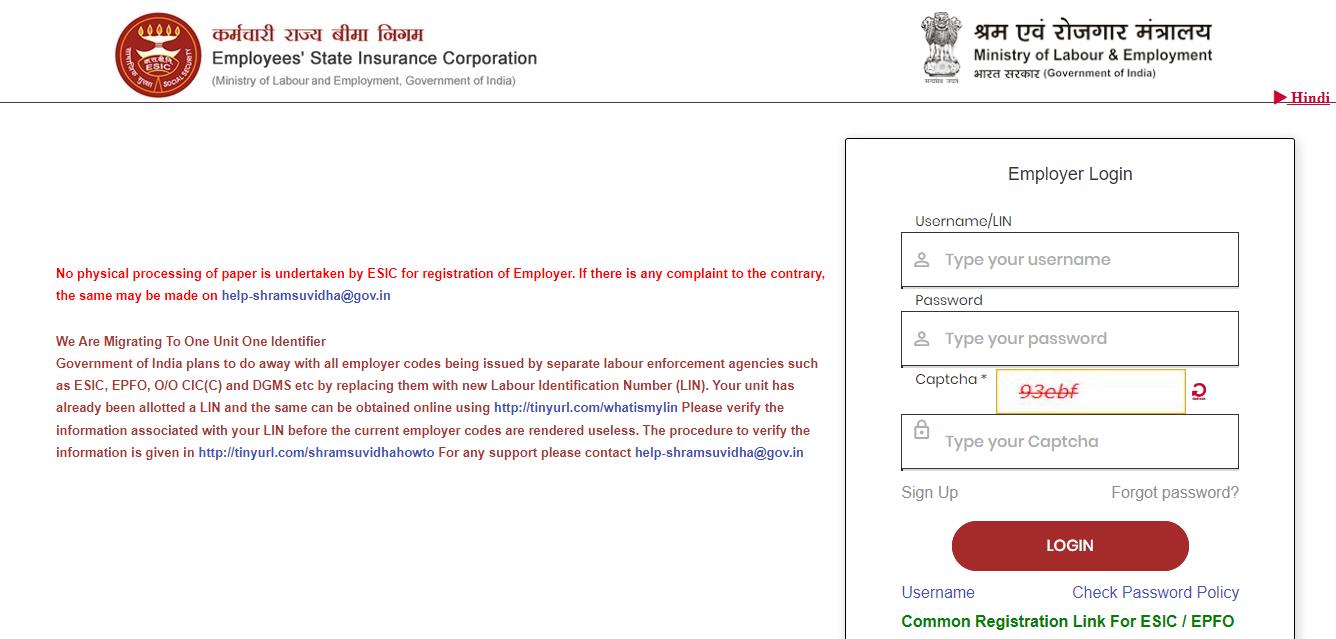
- Upon clicking the 'Sign Up' button, employers are required to complete the form by providing the necessary details and subsequently submitting the form.

Step 2: Receipt of Confirmation Email
- Following the submission of the sign-up form on the portal, the employer will receive a confirmation email sent to the registered email ID and mobile number provided during the sign-up process.
- The email will provide the username and password information, simplifying the process of registering as both an employer and an employee under the ESIC scheme.
Step 3: Accessing Employer Registration Form-1
- Subsequently, access the ESIC portal by selecting the 'Employer Login' option on the home screen. Enter the provided username and password from the confirmation email to log in. Once logged in, navigate to the page featuring the 'New Employer Registration' option.
- Click on the 'New Employer Registration' to proceed with the employer registration process.

- Following that, choose the appropriate 'Type of Unit' from the provided drop-down list, and subsequently, click on the 'Submit' button.
- The 'Employer Registration Form 1' will be displayed, prompting the employer to input relevant details. Within the Employer Registration Form-1 (ESI Registration Form), information related to the employer's unit, employer particulars, factory/establishment details, and employee details should be entered. Once the form is filled out, the employer is required to click the 'Submit' button.
Step 4: Payment for Registration
Upon successful submission of the ESI Registration Form (Form-1), a prompt will appear on the screen instructing the user to make an advance contribution payment. To proceed with the payment, click on the 'Pay Initial Contribution' link.

- The presented initial contribution amount will be visible. Choose the 'Online' option and proceed by clicking the 'Submit' button.
- Make a note of the 'Challan Number' displayed on the screen, then click on the 'Continue' button.
- Subsequently, on the 'Payment Gateway' page, the employer is required to select the preferred mode of payment and enter the designated amount for the transaction.
Step 5: Receipt of Registration Letter
- Following the successful payment of six months' advance contribution, the ESIC department will send the employer a system-generated Registration Letter (C-11) via email. This letter will include a 17-digit Registration Number.
- The Registration Letter (C-11) serves as valid and official proof of the employer's registration within the ESIC system.
Post-ESIC Registration Obligations
Upon successfully registering with ESIC, employers have an ongoing obligation to submit ESI returns every six months. This filing process requires the inclusion of specific essential documents, each playing a crucial role in maintaining compliance and transparency within the ESIC scheme:
Employee Attendance Register:
- A comprehensive record of employee attendance, detailing their presence during the specified period. This document aids in accurately assessing the workforce's engagement and adherence to attendance norms.
Form 6 Register:
- This form serves as a critical register, capturing essential details related to employees, their roles, and other pertinent employment information. It helps in maintaining a systematic record of workforce specifics.
Wages Register:
- The register of wages is a vital document outlining the details of wages paid to employees. It ensures transparency in financial transactions, showcasing adherence to legal and regulatory standards in remuneration.
Register of Accidents:
- This register records any accidents that occur on the business premises, ensuring systematic documentation of incidents. It plays a crucial role in managing workplace safety and facilitates the reporting of incidents as required.
Monthly Returns and Challans:
- Employers are obligated to submit monthly returns and challans, summarizing financial contributions and providing an overview of the workforce's status. These documents are fundamental in ensuring the timely payment of contributions and maintaining accurate records.
ESIC Coverage Criteria for Various Entities
As outlined in the government notification and pursuant to Section 1(5) of the Employees' State Insurance (ESI) Act, various entities under both state and central governments fall under the purview of the ESIC. The coverage criteria differ based on the nature of the establishment and the number of employees:
Entities Covered under State Government:
- Shops
- Restaurants or hotels exclusively involved in sales
- Cinemas, including preview theaters
- Road motor transport establishments
- Newspaper establishments (not covered under the Factory Act)
- Private medical institutions
- Private educational institutions
- Casual employees of Municipal Corporations or Municipal Bodies
For the above-mentioned establishments, mandatory registration with the ESIC is required when they employ 10 or more persons. The owner or employer of the establishment must ensure compliance with this requirement.
Entities Covered under Central Government:
- Shops
- Hotels and restaurants
- Road motor transport establishments
- Cinemas, including preview theaters
- Newspaper establishments
- Establishments engaged in:
Insurance business
Non-Banking Financial Companies (NBFCs)
Port trust
Airport authorities
Warehousing
For the central government entities listed above, compulsory registration with the ESIC becomes applicable when they employ 20 or more persons. This ensures a broader scope of coverage for a diverse range of establishments, fostering the extension of social security benefits to a larger workforce.
In both cases, adherence to these regulations is essential for the owner or employer of the establishment to contribute to the collective welfare of the workforce and fulfill legal obligations under the ESIC framework.
ESIC Benefits
The ESI Scheme offers several advantages, leveraging contributions from both employees and employers. Here are the key benefits:
Contribution Structure: Employees contribute 0.75% of their wages, while employers contribute 3.25% of the wages paid or payable for employees in each wage period.
Medical Treatment Access: Individuals enrolled in the scheme and their families have the opportunity to avail themselves of medical treatments, ensuring comprehensive healthcare coverage.
Maternity Benefits for Women: Female beneficiaries are entitled to maternity benefits as part of the ESI scheme, providing crucial support during pregnancy and childbirth.
Disability and Fatality Benefits: Dependents of insured individuals are eligible for disablement benefits and pensions in the unfortunate event of employment-related disabilities or fatalities, providing financial assistance during challenging times.
Outpatient Medical Services: Beneficiaries can access outpatient medical services through a vast network of 1,418 ESI dispensaries, catering to a range of healthcare needs.
Inpatient Care Facilities: Inpatient care is available at 145 ESI hospitals, collectively offering an impressive total of 19,387 beds. This ensures that beneficiaries receive comprehensive and quality healthcare services when hospitalization is required.
Get ESI card or Pehchan Card
- Visit the ESIC e-pehchan Portal
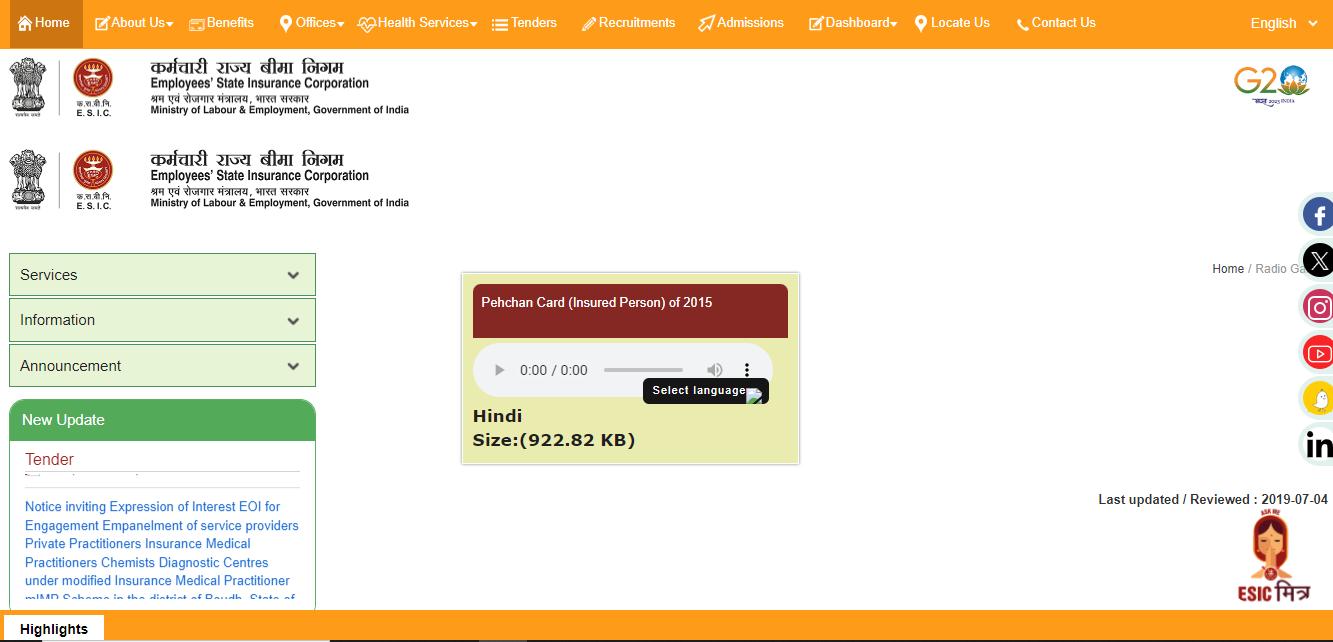
- Select the 'e-Pehchan card' option within the 'Employee' tab.
- Provide the 'Employee Insurance number' and click on the 'View' button.
- Select the 'View counterfoil' option under 'Registration Employee Details.'
- The e-Pehchan card counterfoil for the insured person will be displayed. The employer should print a copy.
- The employer hands over the counterfoil to the employee.
- The employee must submit their photograph along with photos of their dependents to the employer for attestation.
- Following attestation, the employer submits the e-Pehchan counterfoil to the nearest ESIC office to acquire an ESI card.
- Download the Pehchan application form from the ESIC portal, filling in the employee's details.
- The employee submits a family photograph, including dependents, to the employer for attestation.
- After signing the Pehchan application form, the employee takes the form and their dependents to the nearest ESIC office.
- At the ESIC office, the employee's and their dependents' photos and fingerprints will be recorded.
- Within 30 days, a set of 2 cards will be dispatched to the insured person, either through courier delivery or collection from the nearest ESIC branch.
Features of ESIC Card
The ESI card offers a range of features to ensure seamless access to benefits under the ESI scheme, even when changing employment. Here are key aspects:
- Continuity Across Jobs: Individuals can use the same ESI card across different jobs, ensuring uninterrupted access to ESI scheme facilities.
- Employment Transition: In case of a job change, the insured person needs to inform the new employer and provide them with the insurance number associated with the ESI card.
- Online Registration and Modifications: Employees have the flexibility to register and modify their contributions/benefits through the ESIC portal using their insurance number, facilitating easy management of ESI details.
- Information Update: Any changes to personal details like mobile number, email, or address can be communicated to the employer for timely updates in the ESI records.
- Card Retrieval: If an insured person has enrolled for an ESI card in a previous job but has not received it, they can contact the previous employer or visit the nearest ESIC office to obtain the card.
- Facilitates Medical Treatment: Carrying the ESI card or Smart card is advised for quick and convenient access to medical facilities at ESI network hospitals. The card also serves as a valuable tool for tracking one's medical treatment history.
Login to ESIC mEUD
To access your ESIC account, follow these steps:
- Select the mEUD option on the ESIC site.
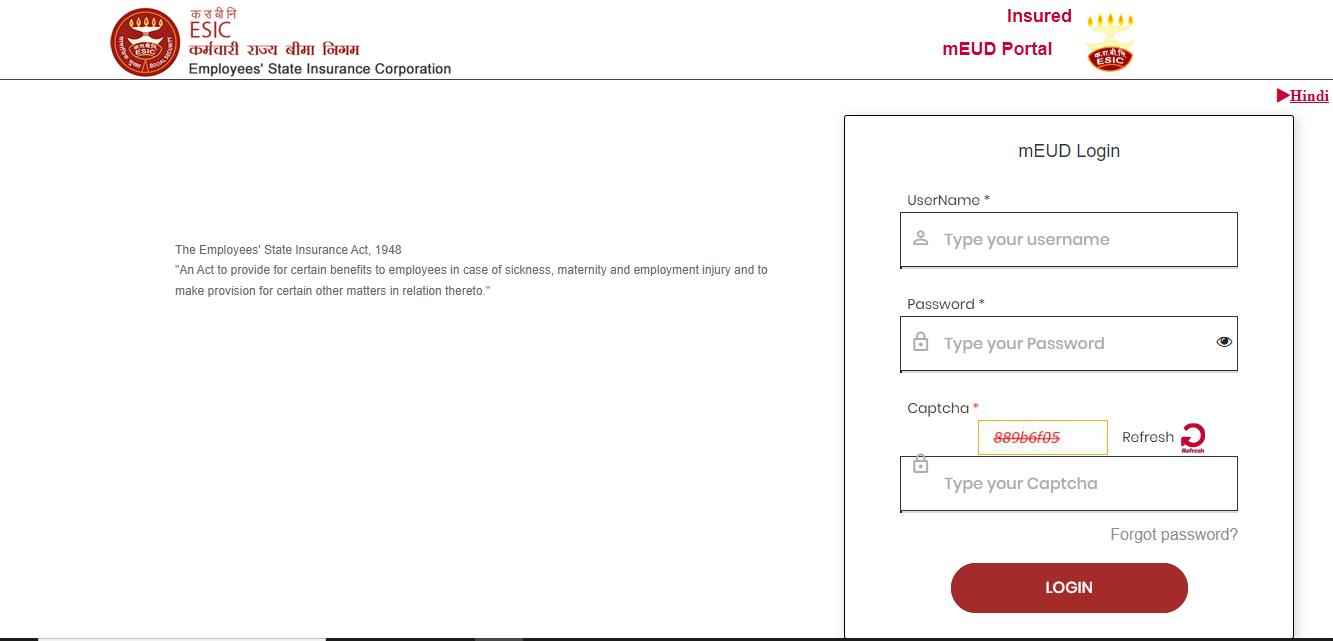
- Enter your login credentials, including your username, password, and the captcha code.
- Click on the 'Login' button to proceed with the sign-in process.
Lodge a Grievance on ESIC Portal
To submit a grievance on the ESIC login portal, follow these steps:
- Navigate to the ESIC portal
- On the homepage, locate and select 'Lodge a Grievance' within the Public Grievance section.
- You will be directed to a different page.
- Click on 'Lodge Public Grievance' under the Grievance category.
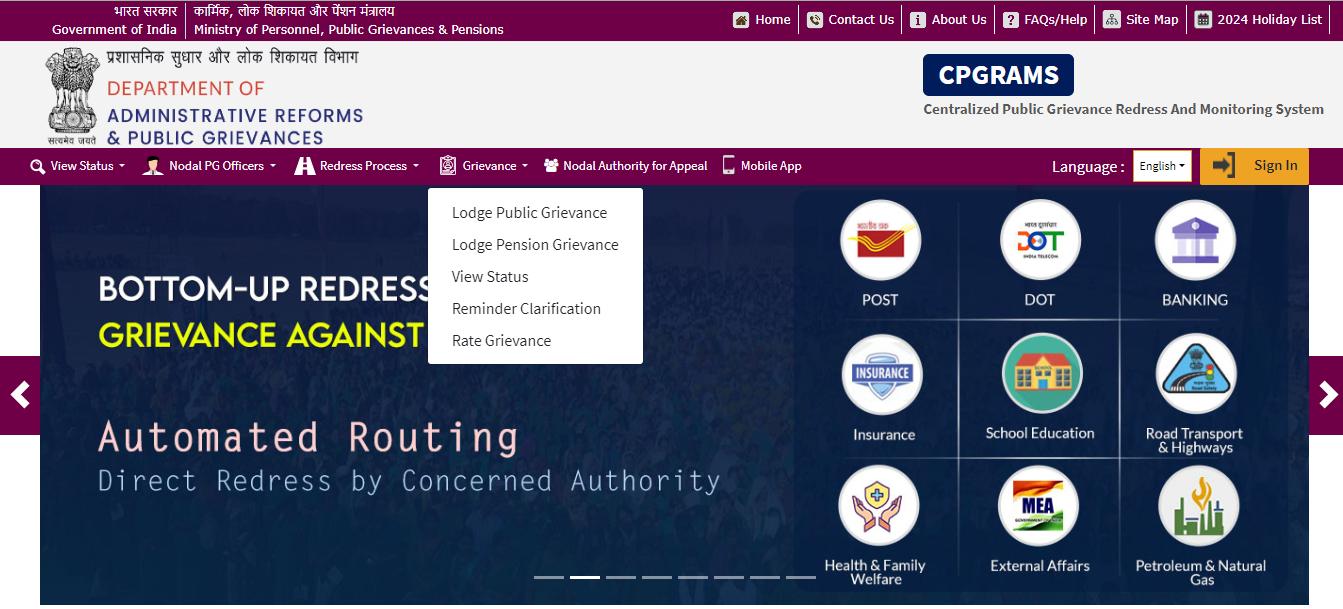
- For registered users, access the CPGRAMS platform by logging in with your username and password in the User Login section. If you are using ESIC for the first time, simply click on the appropriate link to initiate the registration process.
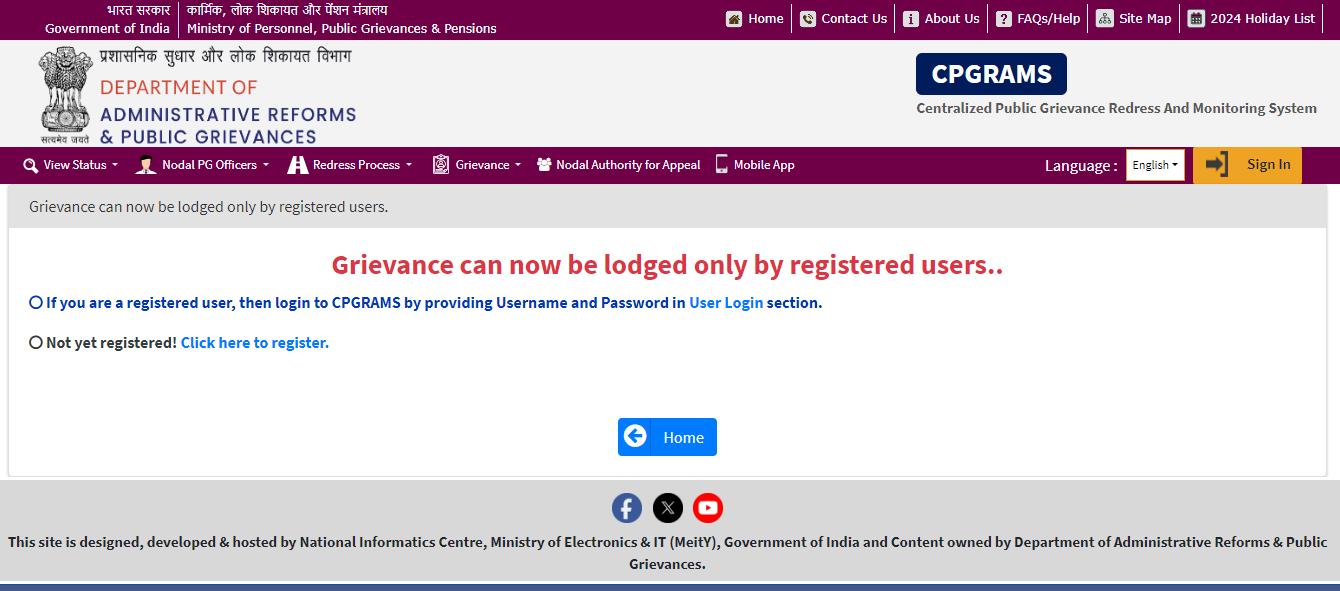

- In the 'Grievance Detail' section, opt for 'Others/Not Listed/Not Known.' From the Ministry/Department Dropdown, pick ESIC. Next, choose the Regional Office from the Subordinate Department/Office options. Provide the necessary details of your complaint.
Check Grievance Status on ESIC
To check the status of a grievance, follow these steps:
1. Navigate to the home page and select 'Lodge a Grievance' within the Public Grievance section.
2. You will be directed to a different page.
3. Click on 'View Status.'
4. On the subsequent page, input the registration number, email ID/mobile number, and security code in the provided fields. Click 'Submit' to proceed and view the status.
IP number in ESIC
The IP number, or Insurance Number, within the ESIC portal is a distinct identification assigned to each insured individual. This unique number is provided to facilitate the seamless utilization of ESIC benefits by the insured person. It serves as a personalized reference, ensuring efficient access to the various privileges and services offered under the Employees' State Insurance Corporation. The IP number acts as a key identifier, streamlining the process for individuals to avail themselves of the comprehensive range of benefits and resources provided by the ESIC.
ESIC IP Number Digits
The ESIC IP number, also recognized as the code number, consists of a total of 17 digits. This distinctive identification number is specifically assigned to each establishment or factory registered under the Indian provisions of the Employees' State Insurance (ESI) Act. The 17-digit structure of the IP number serves as a comprehensive identifier for the registered entities, ensuring precise and unique recognition within the ESIC framework. This alphanumeric code plays a crucial role in the systematic organization and management of records, facilitating the efficient administration of benefits and services outlined in the ESI Act for both employers and employees.
Delayed Payment of Contribution Consequences
In the event of delayed payment of contributions, employers are subject to consequences as outlined in Regulation 31 of the act. If an employer fails to remit the contribution amount within the stipulated time frame, they will incur a financial penalty in the form of simple interest. This interest accrues at a rate of 12% per annum, applicable to each day of delay or default in payment.
This provision is in place to ensure timely and consistent contributions to the Employees' State Insurance Corporation (ESIC). The application of interest serves as a deterrent, encouraging employers to adhere to the prescribed payment timelines. By imposing this interest rate, the regulatory framework aims to maintain the financial stability of the ESIC and sustain the provision of benefits to employees. Employers are thus incentivized to fulfill their contribution obligations promptly to avoid additional financial liabilities associated with delayed payments.
Contact ESIC
To access contact details for ESIC login assistance, users can navigate to the home page and select the 'Contact Us' option. For direct communication with the Employees' State Insurance Corporation, individuals may use the following address:
Headquarters, Panchdeep Bhawan,
Comrade Inderjeet Gupta (CIG) Marg,
New Delhi 110002.
For resolving online application issues, a toll-free number is available at 1800-11-2526. Additionally, individuals can inquire about medical-related matters and seek advice by contacting 1800-11-3839. These contact channels are designed to provide prompt and efficient assistance to users with various concerns related to ESIC services.
Conclusion
To conclude, the Employees' State Insurance Corporation (ESIC) is a pivotal institution in India, administering the Employees' State Insurance (ESI) scheme to ensure the health and welfare of employees across diverse industries. Through mandatory registration, a dual contribution structure, and a unique 17-digit IP number, ESIC provides a robust social security framework. The organization's commitment to timely contributions is emphasized by the imposition of interest on delayed payments, underlining the significance of financial diligence.
ESIC's user-friendly approach is evident in its online portal, facilitating easy registration, grievance resolution, and access to contact details. The comprehensive benefits offered, including medical treatment, maternity support, and disability benefits, contribute to a holistic approach to employee well-being. The ESIC card, with its features promoting continuity across jobs, underscores the organization's commitment to providing uninterrupted access to benefits amid employment transitions. In essence, ESIC plays a vital role in fostering a healthy and resilient workforce, aligning with its broader goal of contributing to the socio-economic development of the nation.
explore further
Latest from Editorials
More from Publications
Resources
Dwello, for every home buyer, is a way to go from 'I feel' to 'I know', at no extra cost.




